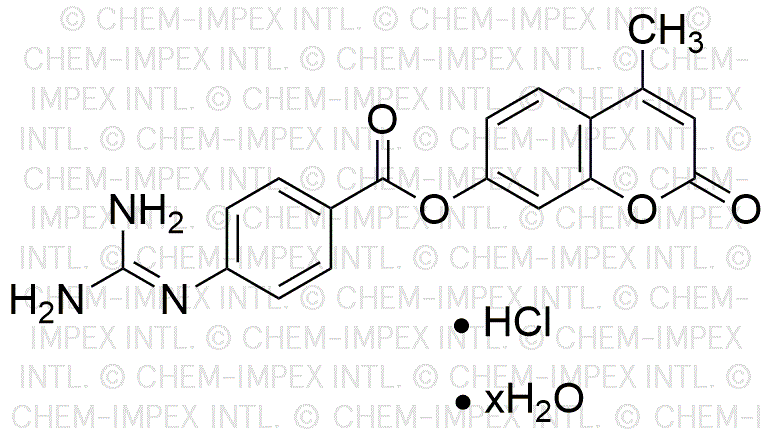4-Methylumbelliferyl 4-guanidinobenzoate hydrochloride hydrate is widely utilized in research focused on:
- Enzyme Activity Assays: This compound is commonly used as a substrate in enzyme assays, particularly for measuring the activity of proteases. Its fluorescent properties allow for easy detection and quantification, making it a valuable tool in biochemical research.
- Cellular Studies: Researchers employ this chemical in cell culture experiments to study cellular processes and signaling pathways. Its ability to penetrate cell membranes enhances its utility in live-cell imaging.
- Drug Development: In pharmaceutical research, it serves as a model compound for developing and testing new drugs, especially those targeting proteolytic enzymes. This aids in identifying potential therapeutic candidates.
- Diagnostics: The compound is also used in diagnostic assays to detect specific enzyme activities related to various diseases, providing insights into disease mechanisms and aiding in early diagnosis.
- Biotechnology Applications: Its role in biotechnological applications includes the development of biosensors that utilize enzyme-substrate interactions, which can be crucial for environmental monitoring and food safety testing.
Informations générales
Propriétés
Sécurité et réglementation
Applications
4-Methylumbelliferyl 4-guanidinobenzoate hydrochloride hydrate is widely utilized in research focused on:
- Enzyme Activity Assays: This compound is commonly used as a substrate in enzyme assays, particularly for measuring the activity of proteases. Its fluorescent properties allow for easy detection and quantification, making it a valuable tool in biochemical research.
- Cellular Studies: Researchers employ this chemical in cell culture experiments to study cellular processes and signaling pathways. Its ability to penetrate cell membranes enhances its utility in live-cell imaging.
- Drug Development: In pharmaceutical research, it serves as a model compound for developing and testing new drugs, especially those targeting proteolytic enzymes. This aids in identifying potential therapeutic candidates.
- Diagnostics: The compound is also used in diagnostic assays to detect specific enzyme activities related to various diseases, providing insights into disease mechanisms and aiding in early diagnosis.
- Biotechnology Applications: Its role in biotechnological applications includes the development of biosensors that utilize enzyme-substrate interactions, which can be crucial for environmental monitoring and food safety testing.
Documents
Fiches de données de sécurité (FDS)
La FDS fournit des informations de sécurité complètes sur la manipulation, le stockage et l’élimination du produit.
Spécifications du produit (PS)
Le PS fournit une description complète des propriétés du produit, notamment sa composition chimique, son état physique, sa pureté et les exigences de stockage. Il détaille également les plages de qualité acceptables et les applications prévues du produit.
Certificats d'analyse (COA)
Recherchez des certificats d'analyse (COA) en saisissant le numéro de lot du produit. Les numéros de lot et de lot se trouvent sur l'étiquette d'un produit, après les mots « Lot » ou « Lot de fabrication ».
Numéro de catalogue
Numéro de lot/série
Certificats d'origine (COO)
Ce certificat d'exploitation confirme le pays dans lequel le produit a été fabriqué, et détaille également les matériaux et composants utilisés et s'il est issu de sources naturelles, synthétiques ou autres sources spécifiques. Ce certificat peut être requis pour les douanes, le commerce et la conformité réglementaire.
Numéro de catalogue
Numéro de lot/série
Fiches de données de sécurité (FDS)
La FDS fournit des informations de sécurité complètes sur la manipulation, le stockage et l’élimination du produit.
DownloadSpécifications du produit (PS)
Le PS fournit une description complète des propriétés du produit, notamment sa composition chimique, son état physique, sa pureté et les exigences de stockage. Il détaille également les plages de qualité acceptables et les applications prévues du produit.
DownloadCertificats d'analyse (COA)
Recherchez des certificats d'analyse (COA) en saisissant le numéro de lot du produit. Les numéros de lot et de lot se trouvent sur l'étiquette d'un produit, après les mots « Lot » ou « Lot de fabrication ».
Numéro de catalogue
Numéro de lot/série
Certificats d'origine (COO)
Ce certificat d'exploitation confirme le pays dans lequel le produit a été fabriqué, et détaille également les matériaux et composants utilisés et s'il est issu de sources naturelles, synthétiques ou autres sources spécifiques. Ce certificat peut être requis pour les douanes, le commerce et la conformité réglementaire.


